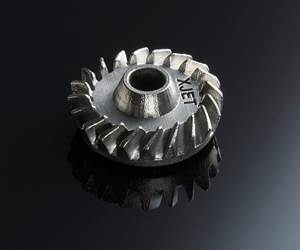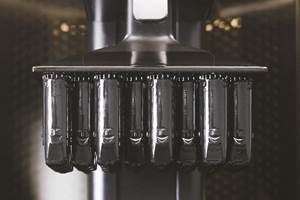5 Ways for a Machine Shop to Use 3D Printing
Additive manufacturing systems are not replacing lathes, but the two processes can work together and complement one another.
Share
Read Next
At first thought, seeing how additive manufacturing could fit into a CNC machine shop may be difficult. But as these shops begin expanding their capabilities, it is natural for them to consider additive manufacturing. Eric Miller, co-owner and principal of Phoenix Analysis & Design Technologies, Inc. (PADT), recently spoke with Production Machining (sister publication to Additive Manufacturing) about how these two processes could work together.
In the article “Additive Manufacturing in the Turning Shop,” he suggests five ways turning shops could use or encounter additive manufacturing:
- Tooling and fixturing. For polymer 3D printing, Miller says the number one use in the machining space is tooling. Although turning does not require the complicated tooling and fixturing of milling, additive manufacturing can still prove useful. For example, a shop could 3D print a plastic sleeve to protect delicate parts from being damaged by the chuck as they are being turned. The sleeve fits around the part, and both go into the chuck.
- Designs and prototypes. Polymer AM is also well-suited for design and prototyping. For shops that do a lot of up-front prototyping, buying a 3D printer and doing the work in house could be more cost-effective than outsourcing the work. Polymer 3D printing offers a quick turnaround on prototypes, which can be used to determine form, fit and possibly function. “You can make sure the parts are good before you go to machining and make 300 or 3,000 of them,” Miller says. He adds that 3D printing can help speed the design process for design engineers. “Advanced rendering capabilities allow us to visualize work on a computer screen quite well these days, but there’s nothing like holding it in your hand and putting the parts together to see if they fit,” he says.
- Replacing metal castings and weldments. Metal AM can be used instead of a number of different processes for producing parts. For example, injector nozzles that in the past were made of several parts welded together can now be 3D printed as one part. Castings are also being replaced with metal additively manufactured parts. When these parts come out of the 3D printer, they require additional work. “We can’t 3D print really highly accurate surfaces,” Miller says. “We still have to machine those critical surfaces.” Understanding additive manufacturing technology, as well as its strengths and weaknesses will help shops perform these machining operations. Miller sees this as a key area of growth and a big opportunity for shops. For shops that do perform these operations, he adds that it is helpful for them to consider 3D printing as part of their upstream process.
- Producing parts that can’t be machined. Possibly the biggest advantage of additive manufacturing is that it can be used to produce parts that cannot be machined. Aerospace parts and medical implants with complex internal features, for example, can be 3D printed in either metal or plastic. These parts must then be brought into tolerance using machining methods such as turning.
- Repairing parts. According to Miller, hybrid manufacturing systems are mostly used for repair. The additive manufacturing capabilities of these systems are used to add stock to damaged parts, which can then be turned in the same machine to be brought into tolerance.
Related Content
AM 101: NanoParticle Jetting (NPJ)
The proprietary process from XJet builds ceramic and metal parts using nanoparticle suspensions. Learn how NPJ works in this introductory article, part of our AM 101 series.
Read MoreAM 101: Digital Light Synthesis (DLS)
Digital Light Synthesis (DLS) is the name for Carbon's resin-based 3D printing process. How it works and how it differs from stereolithography.
Read MoreHow to Build 10,000+ Shot Molds in Hours
Rapid tooling isn’t so rapid when it takes days to 3D print a metal mold, and then you still must machine it to reach the necessary tolerances. With Nexa3D’s polymer process you can print a mold in hours that is prototype or production ready and can last for more than 10,000 shots.
Read MoreUnderstanding HP's Metal Jet: Beyond Part Geometry, Now It's About Modularity, Automation and Scale
Since introducing its metal binder jetting platform at IMTS in 2018, HP has made significant strides to commercialize the technology as a serial production solution. We got an early preview of the just-announced Metal Jet S100.
Read MoreRead Next
At General Atomics, Do Unmanned Aerial Systems Reveal the Future of Aircraft Manufacturing?
The maker of the Predator and SkyGuardian remote aircraft can implement additive manufacturing more rapidly and widely than the makers of other types of planes. The role of 3D printing in current and future UAS components hints at how far AM can go to save cost and time in aircraft production and design.
Read MoreHybrid Additive Manufacturing Machine Tools Continue to Make Gains (Includes Video)
The hybrid machine tool is an idea that continues to advance. Two important developments of recent years expand the possibilities for this platform.
Read More4 Ways the Education and Training Challenge Is Different for Additive Manufacturing
The advance of additive manufacturing means we need more professionals educated in AM technology.
Read More


















